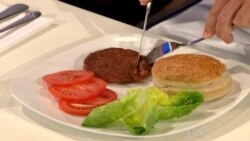Today, scientists unveiled what they are calling the first hamburger to be made from meat produced in a laboratory instead of a cow.
Professor Mark Post, whose laboratory at Maastricht University in the Netherlands developed the processes behind the new burger, which he and his team are calling cultured beef. On Monday, a professional chef cooked the test tube burger in a frying pan and then had two volunteers taste it in front of reporters in London.
The beef was grown in a lab using muscle stem cells taken from a cow. The cells were then placed in a nutrient rich solution in a ring-shaped form around a hub of gel. The muscle stem cells then grew into small strands of meat. It takes about 20,000 such strands to make a 140-gram burger.
Professor Post said the cultured beef production method could be developed into a solution to the growing global demand for meat. The method could also be more environmentally friendly than high-density livestock farming.
“What we are going to attempt is important because I hope it will show cultured beef has the answers to major problems that the world faces,” said Post. “Our burger is made from muscle cells taken from a cow. We haven’t altered them in any way. For it to succeed it has to look, feel and hopefully taste like the real thing.”
In addition to the muscle cells, other ingredients such as salt, egg powder and breadcrumbs went into the burger and red beet juice and saffron were added for color.
Commercial production of cultured beef could begin within 10 to 20 years, the scientist said.
One of those to taste the burger was Austrian food researcher Hanni Rutzler.
"There is quite some intense flavor," Rutzler said. "The look was quite similar to meat. It has quite a bite. The surface of the meat was crunchy - surprisingly. The taste itself was as juicy as meat can be, but different. It tastes like meat, not a meat-substitute like soya or whatever."
Post’s research, which began in 2008, was funded partially by a $330,000 donation from Sergey Brin, co-founder of Google.
Here's a short video about the burger:
Professor Mark Post, whose laboratory at Maastricht University in the Netherlands developed the processes behind the new burger, which he and his team are calling cultured beef. On Monday, a professional chef cooked the test tube burger in a frying pan and then had two volunteers taste it in front of reporters in London.
The beef was grown in a lab using muscle stem cells taken from a cow. The cells were then placed in a nutrient rich solution in a ring-shaped form around a hub of gel. The muscle stem cells then grew into small strands of meat. It takes about 20,000 such strands to make a 140-gram burger.
Professor Post said the cultured beef production method could be developed into a solution to the growing global demand for meat. The method could also be more environmentally friendly than high-density livestock farming.
“What we are going to attempt is important because I hope it will show cultured beef has the answers to major problems that the world faces,” said Post. “Our burger is made from muscle cells taken from a cow. We haven’t altered them in any way. For it to succeed it has to look, feel and hopefully taste like the real thing.”
In addition to the muscle cells, other ingredients such as salt, egg powder and breadcrumbs went into the burger and red beet juice and saffron were added for color.
Commercial production of cultured beef could begin within 10 to 20 years, the scientist said.
One of those to taste the burger was Austrian food researcher Hanni Rutzler.
"There is quite some intense flavor," Rutzler said. "The look was quite similar to meat. It has quite a bite. The surface of the meat was crunchy - surprisingly. The taste itself was as juicy as meat can be, but different. It tastes like meat, not a meat-substitute like soya or whatever."
Post’s research, which began in 2008, was funded partially by a $330,000 donation from Sergey Brin, co-founder of Google.
Here's a short video about the burger:









